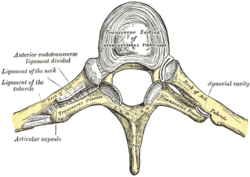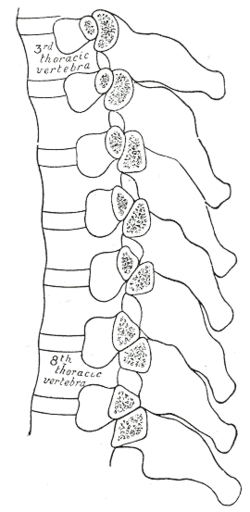Costotransverse joint
The costotransverse joint is the joint formed between the facet of the tubercle of the rib and the adjacent transverse process of a thoracic vertebra. The costotransverse joint is a plane type synovial joint which, under physiological conditions, allows only gliding movement.
| Costotransverse articulations | |
|---|---|
 Costotransverse articulation. Seen from above. | |
 Section of the costotransverse joints from the third to the ninth inclusive. Contrast the concave facets on the upper with the flattened facets on the lower transverse processes | |
| Details | |
| Identifiers | |
| Latin | Articulatio costotransversaria |
| TA | A03.3.04.005 |
| FMA | 7952 |
| Anatomical terminology | |
This costotransverse joint is present in all but the eleventh and twelfth ribs. The first ten ribs have two joints in close proximity posteriorly; the costovertebral joints and the costotransverse joints. This arrangement restrains the motion of the ribs allowing them to work in a parallel fashion during breathing. If a typical rib had only one joint posteriorly the resultant swivel action would allow a rib to be non-parallel with respect to the neighboring ribs making for a very inefficient breathing.
The intercostal nerves innervate the costotransverse joints. Therefore, therapeutic medial branch blocks are ineffectual.
The ligaments of the joint are:
- Articular capsule
- Costotransverse ligament
- Posterior costotransverse ligament
- Lateral costotransverse ligament
- Superior costotransverse ligament
- Inferior costotransverse ligament
- The costotransverse ligament
- Ligament of neck of rib
- Ligament of tubercle of rib
References
This article incorporates text in the public domain from page 300 of the 20th edition of Gray's Anatomy (1918)